Kayda Variations Part 2
(continued from Kayda Variations Part 1)
Kayda variations are developed systematically
Traditional kayda variations are developed systematically, but only roughly. There are some common patterns and approaches, but they are very flexible. And every kayda presents its own possibilities.
Below are some general approaches and techniques, but keep in mind that there will be many exceptions and alternatives to the lists below.
Systematic approaches to creating kayda variations:
- First create variations from the largest phrases in the theme.
- Then create variations from smaller phrases (sub-phrases of the larger ones).
- Focus on bols which have a strong connection.
- Develop multiple variations with the same phrases before moving on to others.
- Include the original theme, or part of the theme, in the new variation.
- Create new themes from smaller phrases, then create variations based on the new theme.
Common techniques for creating kayda variations:
- Repeat bols
- Rearrange bols
- Substitute bols
- Invert bols
- Add pauses between bols
Below we will look at some examples of these guidelines and techniques from our beginner kayda.
Variations from a Beginner Kayda
(Note: The examples below were selected from Benares Kayda 1, but do not follow the exact order of variations for that kayda.)
In the last section, we identified two main phrases (and their khali counterparts) in the main bol:
- dhadha tete (tata tete)
- dhadha dhinna (tata tuna)
Each half has two different versions of these two phrases:
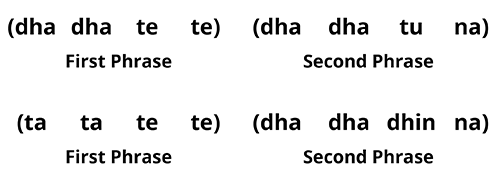
Spoken and Played Twice
So we can think of this kayda as having just two main phrases, not four.
Within the first main phrase of dhadha tete, we have two smaller phrases: dhadha (or tata) and tete. And in the second phrase of dhadha dhinna, we again have dhadha plus dhinna (or tuna).
This gives us three bol groups to work with:
- dhadha (tata)
- tete
- dhinna (tuna)
Below we will look at variations which focus on these three bols.
The Standard Variation: Dohra
The most common variation (and usually the first) is known as dohra (दोहरा), meaning “doubled” or “two-fold”.
In this variation (which we saw in the last section), we repeat the first quarter of the kayda twice, followed by the main bol (version 1). The second half repeats this structure, but begins with the khali version of the first quarter played twice, followed by the main bol with a fully open baya (version 2):
- First quarter x2
- Main bol (Version 1)
- First quarter (khali version) x2
- Main bol (Version 2)
For this kayda, this gives us:
- (dha dha te te) x2
- dha dha te te dha dha tu na
- (ta ta te te) x2
- dha dha te te dha dha dhin na
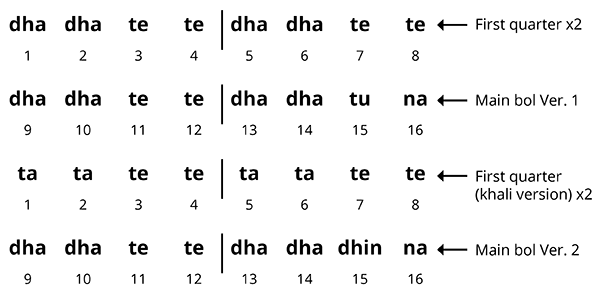
Example 1 (Dohra) – Spoken Twice
Example 1 (Dohra) – Played Twice
Notice that this variation is twice as long as the original, but it keeps the same overall structure of the tal, like the original main bol: tali-tali-khali-tali.
Also notice that Version 1 of the main bol ends with the khali bol tuna, but Version 2 has an open bass throughout, ending with dhinna. This too follows the ending-phrase pattern of the theme discussed in the section on kayda phrases.
This is a common approach mentioned in the list of guidelines above; after creating the new line of our variation, we then include the original theme.
Variations with dhadha and tete
After the standard first variation (dohra), it would be common to create more variations from the bols of the first main phrase dhadha tete. With these two bols dhadha and tete, we can create variations which focus on dha more than tete, and vice-versa. Or simply rearrange the bols where neither bol is emphasized more than the other.
Example 2
The variation below stresses dha. We play dhadha twice, followed by tete, then dhadha again, plus the main bol. Notice that the khali version in the second half includes dhadha at the end (7-8). This is another example of the khali section not always being exactly a quarter in length:
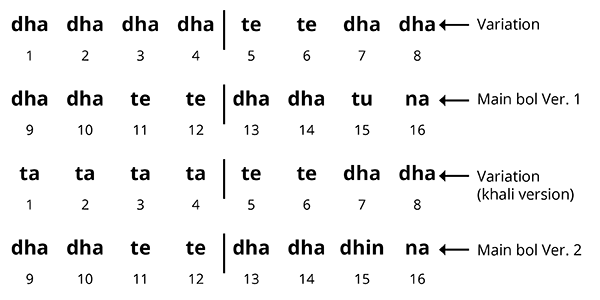
Example 2 – Spoken Twice
Example 2 – Played Twice
Example 3
Example 3 shifts the focus to tete. Here we play dhadha, then tete three times, plus the main bol:
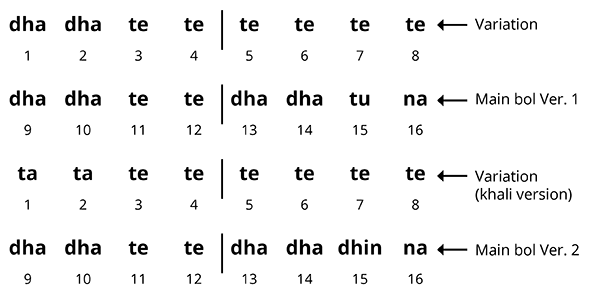
Example 3 – Spoken Twice
Example 3 – Played Twice
Example 4
Example 4 also focuses on tete:
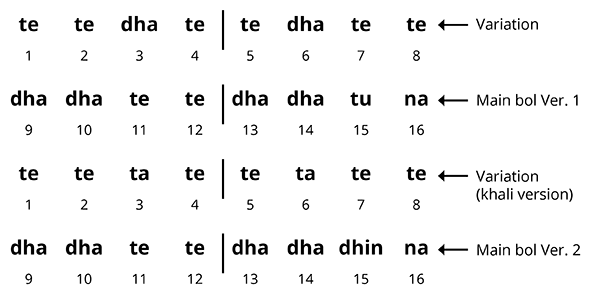
Notice that this variation begins with tete instead of dha or dhadha. This is an example of rearranging bols from the theme.
Variations with tuna/dhinna
After creating a number of variations focusing on dhadha and tetete, a player might then move to tunna/dhinna,.
Example 5
In the variation below, we play dhadha tete once, and then dhadha tuna three times. Notice that this variation begins with the original theme, and then repeats the dhadha tuna twice:
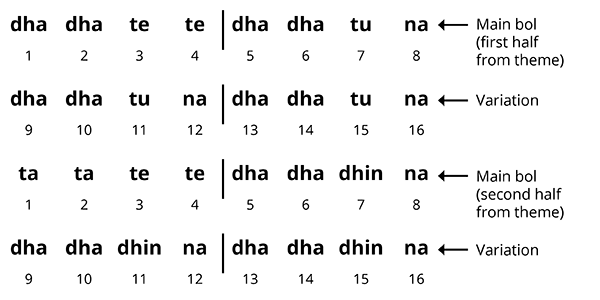
Example 5 – Spoken Twice
Example 5 – Played Twice
Example 6
This variation also focuses on tunna/dhinna. Here we play the phrase dhate tedha dhinna twice, plus dhadha tuna. This variation does not include the complete original theme, but only the second phrase (dhadha tuna/dhadha dhinna). In this way it keeps something of the original character:
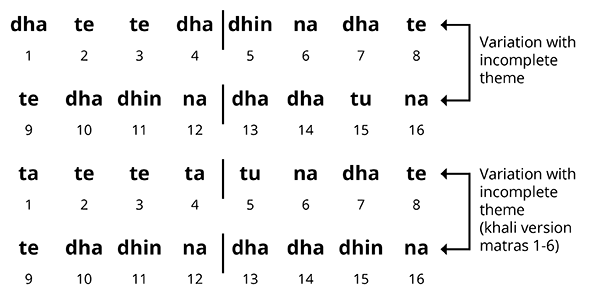
Example 6 – Spoken Twice
Example 6 – Played Twice
Variations with Gaps
Another common way to create variations is to add gaps.
Example 7
This variation focuses again on dhadha tete but now with gaps. This variation also does not repeat the full main bol, but only the second half (dhadha tuna/dhadha dhinna):

Example 7 – Spoken Twice
Example 7 – Played Twice
Example 8
Example 8 also has gaps:
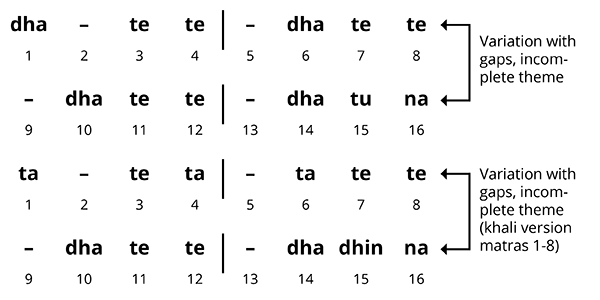
Example 8 – Spoken Twice
Example 8 – Played Twice
Create a new theme based on a sub-phrase
Another common technique for creating variations is to choose a sub-phrase of the main bol, and then create variations from this phrase. Chhotelal Misra called this sub-phrase the “New Main Bol”.
The new main bol is often the first or second quarter of kaydas which are evenly divided into 4 quarters, though it could be any larger phrase which sounds complete on its own. In most cases it will include a typical kayda ending phrase (tu na, tinna kina, etc.).
Our beginner’s kayda above is too short to make a new main bol. Below is a longer kayda (Dilli Beginner Kayda 7) which is better for this purpose. It has two main phrases which can both be used to make new main bols:
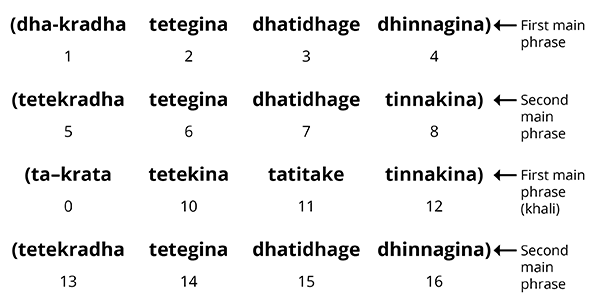
New Main Bol 1
Below is a new main bol made from the first main phrase of the kayda:

Notice that the bols have been adapted to our typical kayda structure: matras 7–8 are now khali (tinna kina), which creates the typical first half ending; the third quarter (matras 9-12) is the khali version of the first quarter, and the last two matras 15-16 (dhinna gina) are the tali version of the first-half ending (matras 7-8).
We can now make variations based on this new main bol using some of the same techniques discussed above.
New Main Bol 2
From the second main phrase of the original theme, we can make another new main bol:

We now have two new main bols from which we can make variations.
Both of these new main bols, and their variations, are included in Dilli Beginner Kayda 7.
Other compositions on this site which include new-main-bol variations are:
Summary
In this section, we looked at just a few examples of how traditional kayda variations are created. If you study any of the kaydas in the Compositions section, you will see again and again the techniques discussed here.
But remember these approaches are flexible. Kayda development is a creative, improvisational art form. Different artists will develop the same kayda in different ways, and the same artist will develop the same kayda in different ways, depending on the audience, time constraints, or mood.
Learning Variations
If you are new listener, I suggest listening in depth—and trying to speak—all of the variations for Benares Kayda 1. Then listen to the solo performance for that kayda where you can hear most of the variation presented in a traditional style. Then move on to other kaydas where you can hear many of the same approaches, but with different phrases.
With beginner kaydas, the variations here are naturally very basic. But it’s important to get familiar with classical tabla’s most elemental phrases and patterns, and all the beginner kaydas on this website, both Dilli and Benares, contain these important phrases.
Once you are familiar with kayda variations, you’ll be able to start appreciating some of the many kayda performances now freely available online.
References
Kippen, James. The Tabla of Lucknow – A Cultural Analysis of a Musical Tradition. Cambridge: Cambridge University Press, 1988.
Misra, Chhote Lal. Tal Prasoon. New Delhi: Kanishka Publishers, 2004. (Hindi)
—. Tal Prabandh. New Delhi: Kanishka Publishers, 2006. (Hindi)
Naimpalli, Sadanand. Tabla for Advanced Students. Mumbai: Popular Prakashan Pvt. Ltd., 2009.
Stewart, Rebecca Marie. The Tabla in Perspective. Unpublished Ph.D. thesis, University of California, Los Angeles, 1974.